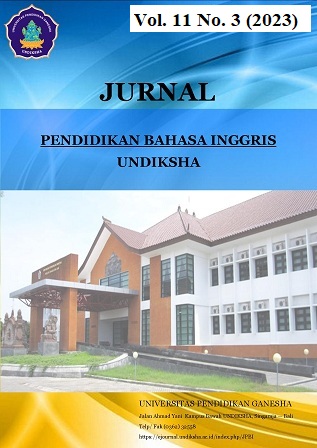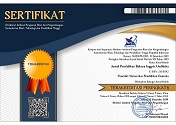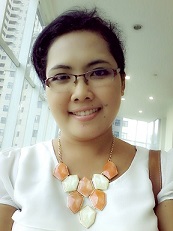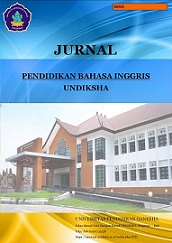The The Multimodal Discourse Analysis on “Teh Pucuk Harum” Advertisement Video
DOI:
https://doi.org/10.23887/jpbi.v11i3.48785Keywords:
Advertisement Video, Interpersonal Meaning, Multimodal Discourse Analysis,Abstract
In the world of digital technology, digital advertisement is a process of introducing and persuading the consumer to buy the product. The advertiser also needs to consider the culture, situation, interaction, and population in which the advertisement is addressed. This study aimed to analyze the interpersonal meaning of the “Teh Pucuk Harum” advertisement video. The research is conducted qualitatively. The current research discusses interpersonal meaning using multimodal discourse analysis. Therefore, the analysis will be done on the video, image, speech, and video length. The research implemented the analytical-qualitative procedures. In order to explore the meaning conveyed by the video in terms of the speech and music, image, and duration. “Teh Pucuk Harum” was chosen as the research object because the drink is popular with Indonesian people and the main ingredients as the commodity in Indonesia. Tea is also well-known as a beneficial plant. Thus, the research found the interpersonal meaning conveyed through the video's speech, music, image, and duration. Combining those components attracts the audience’s attention to buy the product.
References
Aldrich Novrian, & Rizki, M. F. (2021). Integrated Marketing Communication Kedai Sodare Kopi Dalam Meningkatkan Brand Awareness. Medium, 9(1), 81–91. https://doi.org/10.25299/medium.2021.vol9(1).7444.
Bi, M. (2019). Multimodal discourse analysis of news pictures. Theory and Practice in Language Studies, 9(8), 1035–1039. http://academypublication.com/issues2/tpls/vol09/08/tpls0908.pdf#page=147.
Castillo-Cuesta, L. (2022). Using Genially Games for Enhancing EFL Reading and Writing Skills in Online Education. International Journal of Learning, Teaching and Educational Research, 21(1), 340–354. https://doi.org/10.26803/ijlter.21.1.19.
Chang, A. (2011). Web 2.0 Social Network Sites and Facebook Marketing. In BINUS BUSINESS REVIEW (Vol. 2, Issue 2). https://doi.org/10.21512/bbr.v2i1.1181.
Chrishanti, A., Tito, P., & Gabriella, C. (2019). Faktor-faktor iklan yang dapat menarik penonton untuk menonton iklan skip-ads di youtube sampai selesai. Jurnal Akuntansi Maranatha, 11(1), 98–114. https://doi.org/10.28932/jam.v11i1.1544.
Fernández-Fontecha, A., O’Halloran, K. L., Tan, S., & Wignell, P. (2019). A multimodal approach to visual thinking: the scientific sketchnote. Visual Communication, 18(1), 5–29. https://doi.org/10.1177/1470357218759808.
Hardiyana, A. (2016). Optimalisasi Pemanfaatan Teknologi Informasi dan Komunikasi dalam Pembelajaran PAUD. AWLADY: Jurnal Pendidikan Anak, 2(1), 1–12. https://doi.org/10.24235/awlady.v2i1.
Herman, H., Sulistyani, S., Ngongo, M., Fatmawati, E., & Saputra, N. (2022). The structures of visual components on a print advertisement: A case on multimodal analysis. Studies in Media and Communication, 10(2), 145–154. https://ideas.repec.org/a/rfa/smcjnl/v10y2022i2p145-154.html.
Hidayat, D. N., Abrizal, A., & Alek, A. (2019). A multimodal discourse analysis of the interpersonal meaning of a television advertisement in Indonesia. IJEE (Indonesian Journal of English Education), 5(2), 119–126. https://doi.org/10.15408/ijee.v5i2.11188.
Kajamaa, A., & Kumpulainen, K. (2020). Students’ multimodal knowledge practices in a makerspace learning environment. International Journal of Computer-Supported Collaborative Learning, 15(4), 411–444. https://doi.org/10.1007/s11412-020-09337-z.
Kostas, M. (2021). Discursive construction of hegemonic masculinity and emphasised femininity in the textbooks of primary education: children’s discursive agency and polysemy of the narratives. Gender and Education, 33(1), 50–67. https://doi.org/10.1080/09540253.2019.1632807.
Leong, C., Tan, B., Xiao, X., Tan, F. T. C., & Sun, Y. (2017). Nurturing a FinTech ecosystem: The case of a youth microloan startup in China. International Journal of Information Management, 37(2), 92–97. https://doi.org/https://doi.org/10.1016/j.ijinfomgt.2016.11.006.
Lestari, R. P., & Nirmala, D. (2020). Digital storytelling of English advertisement in ESP teaching in Indonesia. EduLite: Journal of English Education, Literature and Culture, 5(1). https://doi.org/10.30659/e.5.1.66-77.
Library, J. H., Ogunrombi, S. A., & Ameh, I. O. (2012). Motivating use of Audio-Visuals in a Nigerian Technological University Library Ngozi Blessing Ossai-Ugbah. Journal of Educational and Social Research, 2(1), 217–224. https://doi.org/10.5901/jesr.2012.02.01.217.
Ly, T. H., & Jung, C. K. (2015). Multimodal discourse: A visual design analysis of two advertising images. International Journal of Contents, 11(2), 50–56. https://pdfs.semanticscholar.org/5d85/65155e936ad335b5c209d3193f7d78f48b11.pdf.
McBride, B. B., Brewer, C. A., Berkowitz, A. R., & Borrie, W. T. (2013). Environmental literacy, ecological literacy, ecoliteracy: What do we mean and how did we get here? Ecosphere, 4(5). https://doi.org/10.1890/ES13-00075.1.
Mohammad, S., Adel, R., Davoudi, M., & Ramezanzadeh, A. (2016). A qualitative study of politeness strategies used by Iranian EFL learners in a class blog Iranian Journal of Language Teaching Research. Iranian Journal of Language Teaching Research, 4(1), 47–62. https://doi.org/10.30466/IJLTR.2016.20377.
Monica, M., & Luzar, L. C. (2011). Efek warna dalam dunia desain dan periklanan. HUMANIORA, 2(9), 1084–1096. https://doi.org/10.21512/humaniora.v2i2.3158.
Moustafa, B. S. M. (2022). A comparative corpus stylistic analysis of thematization and characterization in Gordimer’s My Son’s Story and Coetzee’s Disgrace. Open Linguistics, 8(1), 46–64. https://doi.org/10.1515/opli-2020-0183.
Naderer, B. (2021). Advertising Unhealthy Food to Children: on the Importance of Regulations, Parenting Styles, and Media Literacy. Current Addiction Reports, 8(1), 12–18. https://doi.org/10.1007/s40429-020-00348-2.
Nurhidayat, E. (2021). Utilizing Canva As Digital Tools To Teach Grammar in Remote Learning Period. Journal of English Language Learning, 5(2), 95–99. https://doi.org/10.31949/jell.v5i2.3413.
Olowu, A., & Akinkurolere, S. O. (2015). A multimodal discourse analysis of selected advertisement of malaria drugs. English Review: Journal of English Education, 3(2), 1–8. http://journal.uniku.ac.id/index.php/ERJEE/article/view/205.
Prasetyo, D. D., Yulianto, E., & Sunarti, S. (2016). Pengaruh iklan secara online terhadap keputusan pembelian (Survey pada mahasiswa penggguna produk telkomsel internet 4G LTE). Journal Administrasi Bisnis, 41(1), 170–174. http://download.garuda.kemdikbud.go.id/article.php?article=636350&val=6468.
Salas‐Pilco, S. Z., Yang, Y., & Zhang, Z. (2022). Student engagement in online learning in Latin American higher education during the COVID‐19 pandemic: A systematic review. British Journal of Educational Technology, 53(3), 593–619. https://doi.org/10.1111/bjet.13190.
Shanks, J. D., Izumi, B., Sun, C., Martin, A., & Shanks, C. B. (2017). Teaching undergraduate students to visualize and communicate Public Health data with infographics. Frontiers in Public Health, 5(NOV), 1–6. https://doi.org/10.3389/fpubh.2017.00315.
Simarmata, R. O., & Lestari, F. D. (2020). Multimodal analysis of “ Teh pucuk harum .” English Teaching and Linguistic Journal (ETLiJ), 1(2), 68–71. https://doi.org/10.30596/etlij.v1i2.4701.
Suseno, B. D. (2019). The strength of justified knowledge sharing on good manufacturing practices: Empirical evidence on food beverage joint venture company of Japan – Indonesia. Quality - Access to Success, 20(170), 130–135. https://doi.org/https://www.researchgate.net/profile/Bambang-Suseno/publication/331428833.
Thomas, N. a., Manning, R., & Saccone, E. J. (2019). Left-handers know what’s left is right: Handedness and object affordance. PLoS ONE, 14(7), 1–20. https://doi.org/10.1371/journal.pone.0218988.
Windels, K. (2016). Stereotypical or just typical: how do US practitioners view the role and function of gender stereotypes in advertisements? International Journal of Advertising, 35(5), 864–887. https://doi.org/10.1080/02650487.2016.1160855.
Yanda, D. P., & Ramadhanti, D. (2018). A multimodal discourse analysis (MDA) on bidadari bermata bening novel by Habiburrahman El-Shirazy. Jurnal Penelitian Pendidikan Bahasa Dan Sastra Indonesia, 4(2), 214–226. https://doi.org/10.22202/jg.2018.v4i2.2597.
Yunus, E. D. S., Primiana, I., Kaltum, U., & Cahyandito, M. F. (2016). The influence of supply chain integration on company performance through competitive advantage in Indonesian pharmaceutical industry. Academy of Strategic Management Journal, 15(3), 291–300. https://www.researchgate.net/profile/Aldrin-Herwany-2/publication/311927795.
Downloads
Published
Issue
Section
License
Copyright (c) 2024 Made Prananda Aditya Salain Salain

This work is licensed under a Creative Commons Attribution-ShareAlike 4.0 International License.
Authors who publish with the Jurnal Pendidikan Bahasa Inggris Undiksha agree to the following terms:- Authors retain copyright and grant the journal the right of first publication with the work simultaneously licensed under a Creative Commons Attribution License (CC BY-SA 4.0) that allows others to share the work with an acknowledgment of the work's authorship and initial publication in this journal
- Authors are able to enter into separate, additional contractual arrangements for the non-exclusive distribution of the journal's published version of the work (e.g., post it to an institutional repository or publish it in a book), with an acknowledgment of its initial publication in this journal.
- Authors are permitted and encouraged to post their work online (e.g., in institutional repositories or on their website) prior to and during the submission process, as it can lead to productive exchanges, as well as earlier and greater citation of published work. (See The Effect of Open Access)













